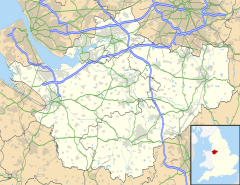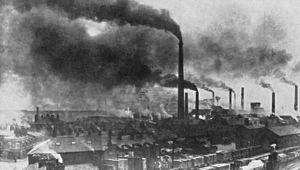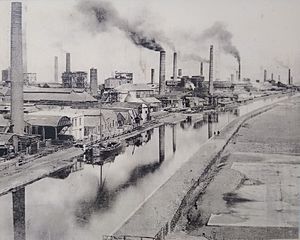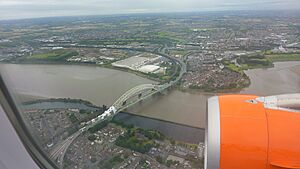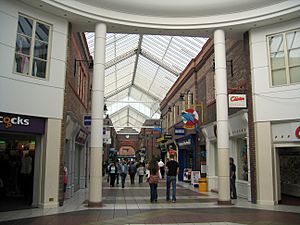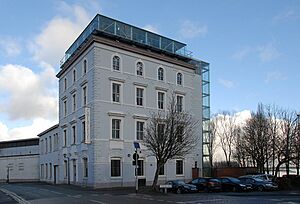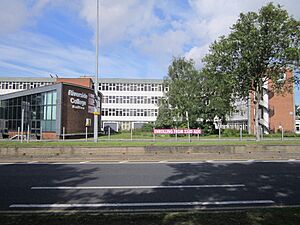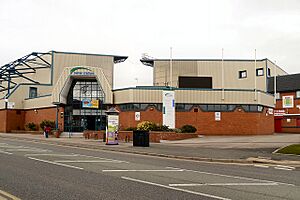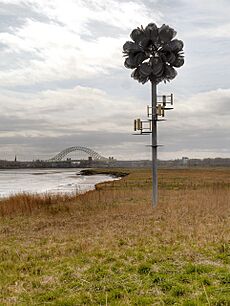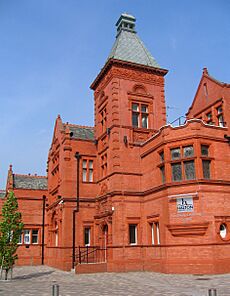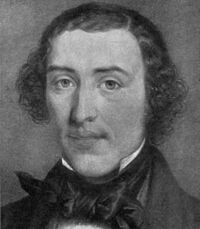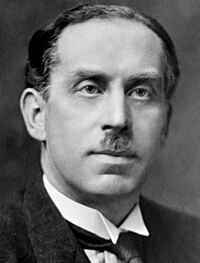Widnes facts for kids
Quick facts for kids Widnes |
|
|---|---|
| Town | |
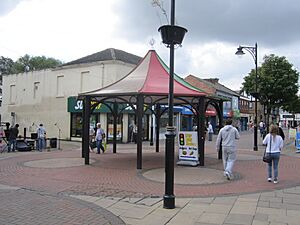 Widnes Town Centre |
|
| Population | 62,400 (2021) |
| Demonym | Widnesian |
| OS grid reference | SJ 5124 8527 |
| • London | 169 mi (272 km) SE |
| Unitary authority | |
| Ceremonial county | |
| Region | |
| Country | England |
| Sovereign state | United Kingdom |
| Post town | WIDNES |
| Postcode district | WA8 |
| Dialling code | 0151 |
| Police | Cheshire |
| Fire | Cheshire |
| Ambulance | North West |
| EU Parliament | North West England |
| UK Parliament |
|
Widnes (pronounced WID-nuss) is an industrial town in Cheshire, England. It is part of the Borough of Halton. In 2021, about 62,400 people lived there.
Widnes is on the north side of the River Mersey. The river here gets very narrow, forming the Runcorn Gap. Right across the river to the south is the town of Runcorn. About 8 miles (13 km) east is Warrington, and 4 miles (6 km) west is Speke, a part of Liverpool.
Before the Industrial Revolution, Widnes was a small village surrounded by marsh and moorland. In 1847, a chemist named John Hutchinson opened a chemical factory at Spike Island. The town quickly grew and became a major center for making chemicals. Many people moved here for work, especially from Ireland, Poland, Lithuania, and Wales. Today, Widnes still makes chemicals, but many older factories have closed. The town's economy now mostly relies on service jobs.
Widnes has two railway stations, Widnes and Hough Green. They are on the train line between Liverpool and Manchester. The main roads are the A557 (north-south) and the A562 (east-west). The old Sankey Canal ends at Spike Island. The Silver Jubilee Bridge crosses the River Mersey. In 2017, the Mersey Gateway Bridge opened to help with traffic. The Catalyst Science Discovery Centre is a museum about the chemical industry. It is in Hutchinson's old office building. The town's stadium is home to the Widnes Vikings rugby league team.
The motto of Widnes is a Latin phrase, Industria Ditat, which means "Industry Enriches."
Contents
History
What's in a Name?
The name Widnes most likely comes from old Danish words. Vid means wide, and noese means nose. This might describe the piece of land that sticks out into the River Mersey. However, this land isn't very wide. Another idea is that ved means a wood, suggesting a tree-covered piece of land. Older spellings of the name include Vidnes, Wydnes, and Wydness.
Early Days
There isn't much proof of people living here a long time ago. But a flint arrowhead found at Pex Hill suggests some human presence in the Stone Age. Pex Hill is an old quarry north of town. Roman roads didn't go through Widnes, but some Roman coins were found near where Ditton railway station is now.
In the 9th century, Vikings came to England. Widnes was at the very edge of the Danelaw, an area ruled by Vikings. The River Mersey gets its name from an old Anglo-Saxon phrase, maeres ea, meaning "boundary river." This river was the boundary between the Danelaw and the Saxon kingdom of Mercia.
After the Norman conquest of England, William the Conqueror gave the land of Lancaster to Roger the Poitevin. He then gave the Widnes area to Yorfrid. Yorfrid had no sons, so his land passed to the Barony of Halton. The St. Luke's Church in Farnworth was built around 1180. In 1507, a grammar school was started in Farnworth. Until the mid-1800s, Widnes was just small villages like Farnworth, Appleton, Ditton, Upton, and Woodend.
In the 1750s, the Sankey Canal was built. This canal connected St. Helens to the River Mersey. Later, in 1833, the canal was extended to Woodend. In the same year, the St Helens and Runcorn Gap Railway opened. This railway connected St Helens to an area in Woodend, which became known as Spike Island. The canal and railway met here, and Widnes Dock, the world's first railway dock, was created. Even with these transport links, the Industrial Revolution didn't fully arrive in Widnes until 14 years later, when John Hutchinson came to Spike Island.
The Chemical Industry Arrives
In 1847, John Hutchinson built his first factory on land between the Sankey Canal and the railway. He made alkali using the Leblanc process. This was a perfect spot because all the raw materials could arrive by water or rail. Finished products could also be sent anywhere. Soon, other chemical factories were built by people like William Gossage and Henry Deacon.
The town grew very fast as homes and services were built for the factory workers. The small villages became part of the growing town of Widnes. Products made included soap, borax, and bleaching powder. Other industries, like iron and copper works, also started. The town became very polluted with smoke and waste from the chemical processes. In 1888, someone called Widnes "the dirtiest, ugliest and most depressing town in England."
Because so many workers were needed, people came from all over the United Kingdom, including Ireland. Many also came from other countries, especially Poland and Lithuania, who were escaping problems in their home countries. Workers also came from Wales. In 1890, the chemical companies joined together to form the United Alkali Company. Widnes became the main center for this new company. However, in the 1890s, the chemical business in Widnes started to decline as new, better ways of making alkali were found elsewhere.
More Recent Times
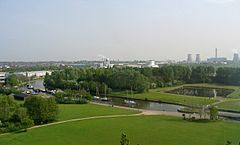
In the early 1900s, the local economy got better. The United Alkali Company started making new products. The town also improved, especially with the opening of the Widnes–Runcorn Transporter Bridge in 1905. This was the first direct road link across the Mersey. In 1909, Widnes was the first town in Britain to have a regular covered double-decker bus service.
By 1919, people's health in the town was getting better. In the 1920s and 1930s, the chemical industry grew and made even more different products. Old, poor housing was replaced with better homes. After World War II, more old houses were removed, and the chemical industry continued to grow. By the 1950s, Widnes had 45 big chemical factories.
In 1961, the Silver Jubilee Bridge opened, replacing the older Transporter Bridge. In 2017, another bridge, the Mersey Gateway Bridge, opened to help with traffic. Both bridges now have tolls.
Today, many of the old, heavy chemical factories have closed. Newer, more modern factories have taken their place. Much of the land that was polluted by the old chemical processes has been cleaned up. This has made the town much cleaner and better for the environment.
Governance
How Widnes is Represented
Widnes is part of the Widnes and Halewood constituency. This means people in Widnes vote for a Member of Parliament (MP) to represent them in the House of Commons in London. An MP is a person elected to speak for their area in the government. Since 2024, Derek Twigg from the Labour Party has been the MP for this area.
Before 2024, Widnes was in the Halton constituency. Widnes first had its own MP in 1885.
Geography
Widnes is on the north side of the River Mersey. The town is mostly flat, with slightly higher areas in Farnworth and Appleton. A piece of land sticks out into the river from Widnes, and another from Runcorn. These two pieces of land form the Runcorn Gap, where the River Mersey gets very narrow. The Runcorn Gap is crossed by the Runcorn Railway Bridge and the Silver Jubilee Bridge. The Silver Jubilee Bridge carries the A533 road.
Widnes has some green areas, like Victoria Park in Appleton. There are also two golf courses in the middle of the town. Most of the chemical factories are near the River Mersey. A second road bridge, the Mersey Gateway, opened in 2017. It has six lanes and connects Runcorn with Widnes.
Water in Widnes drains into the Mersey through small streams. The ground beneath Widnes is mostly sandstone. Most of the sandstone is covered by glacial deposits (stuff left behind by glaciers).
Scientists found a deep gorge (about 100 feet or 30 meters deep) in the bedrock when they were digging for factories in the 1870s. This gorge was filled with glacial deposits. This means that before the Ice Age, the Mersey River flowed in a different path. When glaciers blocked its old path, it made a new channel through the Runcorn Gap.
Widnes is near the west coast and the Irish Sea, so the weather is generally mild. It doesn't get too hot or too cold. The average temperature between 1971 and 2000 was about 9.4 to 9.7 °C. This is a bit warmer than the average for the UK. Widnes also gets a bit more sunshine than the UK average. The average rainfall is a bit less than the UK average. It rarely snows in Widnes, and there are few days with frost.
Demography
How Widnes Has Grown
Widnes was a small place until factories started to appear in the 1800s. This caused the population to grow a lot.
| Year | Population | Change as % |
|---|---|---|
| 1801 | 1,063 | — |
| 1811 | 1,204 | +13.3% |
| 1821 | 1,439 | +19.5% |
| 1831 | 2,209 | +53.5% |
| 1841 | 3,211 | +45.4% |
| 1851 | 3,211 | |
| 1861 | 6,905 | +115.0% |
| 1871 | 14,359 | +108.0% |
| 1881 | 24,935 | +73.7% |
| 1891 | 30,011 | +20.4% |
| 1901 | 28,580 | −4.8% |
| 1911 | 34,541 | +20.9% |
| 1921 | 38,860 | +12.5% |
| 1931 | 40,619 | +4.5% |
| 1939 | 40,347 | −0.6% |
| 1951 | 48,795 | +20.9% |
| 1961 | 52,168 | +6.9% |
| 1971 | 56,953 | +9.2% |
| 1981 | 54,478 | −4.3% |
| 1991 | 55,708 | +2.3% |
| 2001 | 55,686 | −0.0% |
| 2011 | 61,464 | +10.4% |
| 2021 | 62,400 | +1.5% |
Religions and Beliefs
In the 2021 census, most people in Widnes (64.3%) said they were Christian. This is higher than the average for England. About 29.5% said they had "no religion." A small number of people (1.5%) followed other religions like Buddhism, Hinduism, Islam, or Sikhism.
Widnes has many churches. The Anglican churches are part of the Diocese of Liverpool. The oldest is St Luke's Church, Farnworth. Other Anglican churches include St Mary's and St Paul's. Some churches are shared, like St Michael's, which Anglicans share with Hough Green Methodist Church.
The Roman Catholic churches are part of the Archdiocese of Liverpool. There are four Catholic churches in Widnes, including St Bede's and St Michael's. Some Catholic churches have closed in recent years.
There are also Methodist churches, a Baptist church, and an Evangelical Christian church. The Foundry is a Pentecostal church. Jehovah's Witnesses have a Kingdom Hall, and there is a Spiritualist church.
Different Backgrounds
In the 2021 census, most of Widnes's residents (96.5%) were White. Small percentages were from mixed ethnic groups (1.3%), Asian backgrounds (1.2%), or Black backgrounds (0.4%). Most people (97.3%) spoke English as their first language.
Economy
In 2020, the total value of goods and services produced in Widnes was about £1.18 billion.
Widnes is still an industrial town, and making chemicals is a big part of its economy. However, the town's economy has changed, and now many jobs are in service industries. In 2006, a new freight park called 3MG Mersey Multimodal Gateway opened. This park helps move goods between roads, air, sea, and trains. In 2010, the first part of Stobart Park opened. This is a large warehouse and distribution center, including a huge refrigerated warehouse for Tesco.
In 2014, work started on the new Mersey Gateway bridge, which opened in October 2017. This new six-lane toll bridge crosses the River Mersey between Runcorn and Widnes. It helps reduce traffic on the older Silver Jubilee Bridge. The new bridge and its roads are important for connecting the Liverpool area, including Liverpool John Lennon Airport and the Port of Liverpool, to the rest of North West England.
Widnes has many shopping areas. The Greenoaks Centre, a shopping mall, opened in 1995. It's next to the old Widnes Market, which has both an indoor market hall and an outdoor market. There's also a Morrisons supermarket nearby. A large Asda superstore opened in 2004. A new shopping area called Widnes Shopping Park opened in 2010. It has popular stores like Marks & Spencer, Next, New Look, and Boots. Other businesses there include Wilko, Costa Coffee, Halfords, Buzz Bingo, and KFC.
In 2011, a large Tesco Extra store began construction and opened in March 2012. This big store is built on stilts, with a car park underneath for about 600 cars.
Landmarks
The Silver Jubilee Bridge is a special, protected building. It opened in 1961 and connects Widnes to Runcorn. For many years, it was the only bridge crossing the River Mersey west of Warrington. In 2017, the new Mersey Gateway bridge opened to help with traffic and make it easier to get to the Liverpool area.
Cleaning up old chemical factory sites has created new opportunities. These include Victoria Promenade along the River Mersey and Spike Island. Spike Island is now a large open recreation area with footpaths along the old towpath of the Sankey Canal. Next to Spike Island is the Catalyst Science Discovery Centre, which is in John Hutchinson's old Tower Building.
Widnes has many listed buildings, which are important historical structures. These include Anglican churches like St Luke's Church, Farnworth and St Mary's, West Bank. Roman Catholic churches like St Michael's and St Bede's are also listed. The Widnes and Hough Green railway stations are listed, as are the old Widnes Town Hall and the former power house of the transporter bridge.
Transport
Widnes is on the southern railway line between Liverpool and Manchester. The town has two stations: Hough Green and Widnes. Trains from these stations go to Liverpool and Manchester city center. Some trains from Widnes station also go to Stockport, Sheffield, Nottingham, and Norwich.
For longer journeys to London or the Midlands, people often use Runcorn station and then take a bus or taxi across the Mersey Gateway Bridge to Widnes.
There are plans to extend the Merseyrail train network to Warrington. This would create new connections using the existing route through Widnes railway station.
The main bus companies in Widnes are Arriva North West and Warrington's Own Buses.
The A562 road goes through Widnes, connecting Liverpool to the west and Penketh to the east. The A557 road goes through the town, connecting Runcorn to the south (via the Silver Jubilee Bridge) with the M62 motorway, about 2.5 miles (4 km) north. The Mersey Gateway bridge opened in 2017.
Widnes is about 6 miles (10 km) from Liverpool John Lennon Airport and 25 miles (40 km) from Manchester Airport.
Education
Widnes has nineteen primary schools and three nursery schools. There are three secondary schools: Saints Peter and Paul Catholic High School, Ormiston Chadwick Academy, and Wade Deacon High School. Halton College and Widnes and Runcorn Sixth Form College joined together in 2006 to form Riverside College. There are also three special schools for students with specific needs. The Kingsway Learning Centre offers classes for adults.
As part of a program to improve schools, Fairfield High School closed in 2010 and merged with Wade Deacon High School. Fairfield High School had been around since the 1500s. Its students moved to Wade Deacon High School's new building in 2013. The old school site is now being developed into homes and a cemetery.
Sport
The most famous sports team in Widnes is the Widnes Vikings Rugby League Football Club. They were very successful in the 1970s and 1980s, even becoming World Club Champions in 1989. More recently, they won the Northern Rail Cup in 2007 and 2009. Their home ground is the DCBL Stadium, which is owned by the local council. The stadium also hosts conferences and events. The Widnes Vikings currently play in the Betfred Championship.
Widnes Rugby Union Football Club, also known as "the wids," is an amateur rugby union club. They are based at Heath Road and run by volunteers. The club works with local schools and authorities to help rugby grow in the community.
Widnes Cricket Club started in 1865. Moorfield Sports & Social Club hosts sports like football, rugby league, cricket, and bowls. There is also a private golf club on Highfield Road.
Widnes Tennis Academy has indoor and outdoor courts and a gym. It helps promote tennis in the area and is home to Lane Tennis Club.
Widnes is also home to the Wolfslair MMA Academy, a MMA gym. It was started in 2004 and has trained famous MMA fighters like Michael Bisping and Quinton Jackson.
Widnes F.C. is the town's football club. They play their home matches at Halton Stadium. The club started in 2003 as The Dragons A.F.C. In 2012, it became part of the rugby league team, but in 2014, it became independent again and changed its name to Widnes Football Club. They have been promoted several times and now play in the Evo-Stik Western Division.
Since 2013, Widnes has an ice hockey club called Widnes Wild. They play at the Planet Ice rink in the National Ice Hockey League.
Media
Local news and TV shows for Widnes come from BBC North West and ITV Granada. The local TV station TalkLiverpool also broadcasts to the area. TV signals are received from the Winter Hill TV transmitter.
Local radio stations include BBC Radio Merseyside (95.8 FM), Heart North West (105.4 FM), Capital Liverpool (107.6 FM), Hits Radio Liverpool (96.7 FM), Smooth North West (100.4 FM), Greatest Hits Radio Liverpool & The North West (107.2 FM), and Halton Community Radio (92.3FM).
The town has local newspapers: The Runcorn & Widnes Weekly News and Runcorn and Widnes World.
Culture
The Queens Hall opened in 1957 as a theater and concert hall. It was originally a church. It was used until 2004 and was demolished between 2011 and 2012. Next to it, the Queen's Hall Studio (now called The Studio) was built as a Sunday school in 1879. It closed in 2004 but reopened in 2010 after a lot of effort from volunteers. It's now a community place for music and live shows.
There's a story that the famous song "Homeward Bound" by Simon & Garfunkel was written by Paul Simon at a Widnes train station. Paul Simon once said: "If you know Widnes, then you'll understand how I was desperately trying to get back to London as quickly as possible. Homeward Bound came out of that feeling."
The town of Widnes is also mentioned in the song "The Stars of Track and Field" by the band Belle and Sebastian. The song "Watch Your Step" by Elvis Costello also mentions Widnes.
Community Facilities
The main library in Victoria Square has been updated. Besides regular library services, it has a large collection of materials about railways. There is also a smaller library in the Ditton area.
The Studio, on Lacey Street, is a community center. It hosts live music and theater. It also has a project called ACCESS ALL AREAS for young people interested in music.
Victoria Park in Appleton has many fun things to do. These include a cafeteria, a bandstand, a model boating lake, tennis and basketball courts, and a skateboarding area. It also has glasshouses with a pets' corner and a butterfly house. Hough Green Park and Crow Wood Park are other green spaces in Widnes.
Widnes has several nature reserves. Pickerings Pasture is an area of wildflower meadows overlooking the River Mersey. It was built on an old landfill site. Other nature reserves are Clincton Wood and Hale Road Woodlands.
Kingsway Leisure Centre has a swimming pool, a gym, and a sports hall. There are many football, cricket, and rugby league clubs in town. St Michael's Golf Course was built on old industrial land, but it is currently closed due to high levels of arsenic in the soil. There is also a private golf club on Highfield Road.
In October 2011, the Hive Leisure Park opened as part of the Widnes Waterfront. It has a multiplex cinema called Reel Cinema with five screens. There's also a Frankie & Benny's restaurant, Super Bowl UK Widnes with a 16-lane ten-pin bowling center, a children's play area, a Nando's restaurant, a Premier Inn hotel, a Brewers Fayre pub, and an Ice Rink.
Notable People
Business
James Atherton (1770-1838) was a businessman from Liverpool. He helped turn Everton into a wealthy area and founded the seaside town of New Brighton. He was born in Ditton.
Religion
Three men from or near Farnworth became important in the Anglican church. They were William Smyth (around 1460–1514), who became a bishop and built the grammar school. Richard Barnes (1532–1587) also became a bishop. Richard Bancroft (1544–1610) became the Archbishop of Canterbury. John Tiarks (1903–1974) was a vicar in Widnes and later became a bishop.
Science and Industry
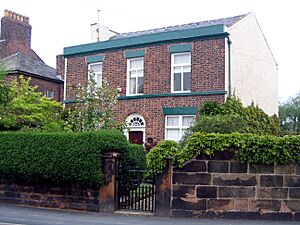
William Gossage (1799–1877) was a chemical maker who started a soap business in Widnes. Many important chemists and factory owners lived in Widnes in the late 1800s. One was Ludwig Mond (1839–1909), who helped start Brunner Mond. He lived in The Hollies, Farnworth. There were three generations of the Holbrook Gaskell family who were chemical industrialists.
Henry Deacon (1822–1876) was a chemist who started a chemical factory in Widnes. John Hutchinson (1825–1865) started the first chemical factory in Widnes in 1847. Henry Brunner (1838–1916) worked for John Hutchinson. Ferdinand Hurter (1844–1898) was a Swiss chemist who joined a chemical business in Widnes in 1867. Neil Mathieson (1823–1906) was a Scottish chemist who started his own business in 1870. Sir John Brunner, 1st Baronet (1842–1919) also worked at Hutchinson's factory and became a general manager.
Vero Charles Driffield (1848–1915) was a chemical engineer. Sir Robert Mond (1867–1938) became a chemist and archaeologist. His younger brother Alfred Mond, 1st Baron Melchett (1868–1930) was a businessman and politician.
Sydney Young (1857 in Farnworth – 1937) was an academic chemist. Charles Glover Barkla (1877 in Widnes – 1944) won the 1917 Nobel Prize in Physics for his work with X-rays. Charles Suckling (1920–2013) was a British chemist who created a type of anesthetic in 1951 while working in Widnes. Gordon Rintoul (born 1955) was the Director of the Catalyst Science Discovery Centre in Widnes from 1987 to 1998.
Military
Born in Farnworth, Roy Chadwick (1893–1947) designed the famous Avro Lancaster bomber. Thomas Mottershead (1893–1917), from Widnes, was a soldier in World War I. He was given the Victoria Cross for his bravery. Another Widnes man, Thomas Wilkinson (1898–1942), also received the Victoria Cross during World War II. Air Marshal Sir Tap Jones (1914 in Widnes – 2007) was a high-ranking officer in the Royal Air Force.
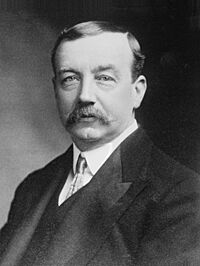
Sport
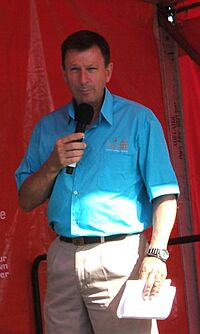
- Johnny Briggs (1862–1902) was a famous cricketer who lived in Widnes.
- Tommy Magee (1899 in Widnes – 1974) was a footballer who played over 400 games for West Bromwich Albion.
- Tommy McCue (1913 in Widnes – 1994) was a rugby league player who played 339 games for Widnes Vikings.
- Nat Silcock Jr. (1927 in Widnes – 1992) was a rugby league footballer with 458 games.
- Alan Prescott (1927 in Widnes – 1998) was a rugby league footballer who played 404 matches for St. Helens.
- Vince Karalius (1932 in Widnes – 2008) was an English rugby league player and coach.
- Tony Karalius (1943 in Widnes – 2019) was a rugby league footballer who played 394 games, mostly for St. Helens.
- Doug Laughton (born 1944 in Widnes) was a professional rugby league footballer with 450 games.
- George Nicholls (born 1944 in Widnes) was a rugby league player with 484 club games.
- John Stephens (born 1945 in Widnes) was a professional rugby league footballer with 393 games.
- Eric Prescott (born 1948 in Widnes – 2023) was a rugby union and rugby league footballer with 503 games.
- David France (born 1948 in Widnes) is an author and historian for Everton football club.
- Mick Adams (1951 in Widnes – 2017) was a professional rugby league footballer who played 438 games, mostly for Widnes Vikings.
- Peter Glynn (born 1954 in Widnes – 2024) was a rugby league footballer who played 402 games, mostly for St. Helens.
- Paul Sherwen (born 1956 in Widnes – 2018) was a former Tour de France cyclist.
- Mike O'Neill (born 1960 in Widnes) was a rugby league footballer who played 414 games for Widnes Vikings.
- Timothy Bostock (born 1966 in Widnes) was a cricketer.
- Andy Currier (born 1966 in Widnes) was a rugby league player with 312 games.
- John Bowles (born 1967 in Widnes) is a professional darts player.
- Andrew Higginson (born 1977) is a professional snooker player who lives in Widnes.
- Martin Hewitt (born 1980 in Widnes) is a mountaineer and businessman.
- Gary Taylor-Fletcher (born 1981 in Widnes) was a professional football player with over 500 appearances.
- Stephen Myler (born 1984 in Widnes) is a rugby union player.
- Lucy Martin (born 1990 in Whiston) was a professional cyclist who grew up in Widnes.
Creative Arts

- Nor Kiddie (born 1897 in Widnes) was a comedian, actor, and juggler.
- Alan Bleasdale (born 1946) is an English screenwriter who went to school in Widnes.
- Michael Kenna (born 1953 in Widnes) is an English photographer known for his black and white landscapes.
- Angela Topping (born 1954 in Widnes) is a British poet and author.
- Ian Finney (born 1966) is a guitarist and songwriter who grew up in Widnes.
- Jane Weaver (born 1972) is a singer, songwriter, and guitarist who grew up in Widnes.
- Melanie C (born 1974), also known as Mel C or Sporty Spice from the Spice Girls, went to school in Widnes.
- David Dawson (born 1982) is an actor who was born and raised in Widnes.
Images for kids


